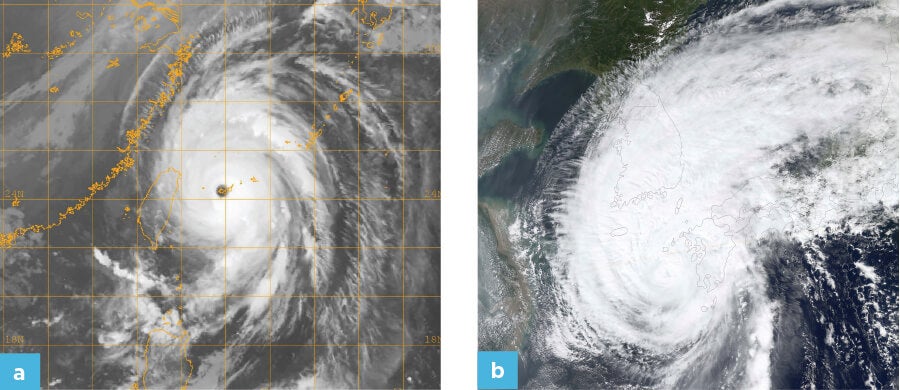RMS has invested considerable resources in developing an advanced approach to explicitly model transitioning typhoons in Japan, writes Margaret Joseph, Asia typhoon product manager. The pioneering work has helped to develop the most advanced Japan typhoon model on the market; one that makes allowances for the realistic patterns of typhoon wind and typhoon flood loss due to transitioning, which are a major driver of typhoon wind and flood damage in Japan.
Not only have more than 50 percent of Japan’s landfalling typhoons either undergone or were undergoing extra-tropical transitioning, all Japan’s largest insured loss-causing typhoons had undergone or were undergoing extra-tropical transitioning when they made landfall. This includes Typhoon Mireille (1991), the costliest typhoon to strike Japan – and Asia as a whole. The importance of understanding and accurately modeling transitioning is, therefore, plainly crucial for catastrophe modelers and for those who use such models for business.
Understanding the Phenomenon
Japan’s geographical position, both its latitude and position under a strong jetstream, make it very susceptible to extra-tropical transitioning typhoons. A transitioning typhoon tends to be the strongest in terms of wind category at landfall, which has implications for a wind-loss perspective.
Extra-tropical transitioning occurs when typhoons in the western North Pacific track toward the pole where they interact with mid-latitude weather systems and the jet stream. If the impact of the interaction is small, then they typically weaken, because of colder sea surface temperatures. If the impact is stronger, then they may change into a different kind of storm, which is initially a hybrid between a tropical cyclone and an extra-tropical cyclone, and which may ultimately end up as a pure extra-tropical cyclone. This transitioning can significantly alter the shape of the wind field, increasing the radius of maximum winds, shifting the location of the strongest winds and, at times, shifting the maximum winds from one side of the typhoon track to the other (Figure 1). Driven by the underlying changes in the wind field, extra-tropical transitioning impacts the storm surge and waves of a typhoon, also affecting the precipitation patterns within a typhoon.

Figure 1. Satellite imagery of Typhoon Shanshan (2006). (a) On September 16 this tropical cyclone was located to the north of Taiwan and (b) three days later it tracked north near Japan and the Korean peninsula having undergone extra-tropical transitioning. The difference in the cloud patterns reflects the difference in the wind field prior to and after extra-tropical transitioning. (This is an example of a left-hand side/comma ETT cyclone.) (Source: Image taken from MODIS, NASA.)
While several generations of RMS tropical cyclone models have included increasingly realistic representations of extra-tropical transitioning, we have recently concluded our largest body of research to better understand and model transitioning, focusing more specifically on typhoons in the western North Pacific. The peer-reviewed research has informed one of the numerous scientific advancements in the forthcoming RMS® Japan Typhoon HD Model.
The rebuilt typhoon model now includes a novel parametric representation of the wind fields that replicates the features specific to extra-tropical transitioning, including accounting for classifications that have a higher probability of occurrence at a given time of year. Also, by being fully coupled, the model represents the impact of extra-tropical transitioning on precipitation, storm surge and wave through changes in the wind field.

Figure 2. Examples of extra-tropical transitioning typhoons showing (a) the right-side wind field (e.g., Typhoon Halong, 2002), (b) the comma-shaped wind field with maximum winds to the LHS/RHS of the track (e.g., Typhoon Rammasun, 2008). (Source: RMS research.)
While wind is a consideration, (re)-insurers must not ignore the flood component of typhoon risk when pricing the risk and modeling portfolio accumulations. Japan’s geographical position in relation to the “average” typhoon track, has implications for the flood hazard. As a typhoon tracks north, into the subtropics and mid-latitude, it can interact with other weather systems and transition to an extra-tropical cyclone. Storms that are transitioning or have transitioned when they impact Japan can bring more intense precipitation and/or storm surge. While Japan has one of the world’s most advanced flood protection systems, a significant proportion of the country lies below sea level. Consequently, if flood and coastal defenses are breached, widespread and severe flooding could ensue.
Overall, typhoon presents both a significant risk as well as a growth opportunity for global (re)insurers. The RMS Japan Typhoon HD Model is designed to help users evaluate all these variables when considering their exposure to typhoon flood.
RMS Research in This Area has Been Published in Scientific Journals
Using a combination of observed data and numerical modeling studies, RMS modelers investigated the difference in the shape and extent of the wind field in extra-tropical transitioning typhoons as compared to the wind field in the tropical phase. Additionally, the RMS team classified different types of transitioning wind fields, with the important implication that in extra-tropical transitioning typhoons the maximum winds are not restricted to the right of the track. In fact, the maximum winds can be located on both sides of the typhoon track; for one type of RMS-classified transitioning the maximum winds can flip across the typhoon track.
The research builds on work from Naoko Kitabatake at the Meteorological Research Institute in Japan, involved work with Professor David Nolan of the University of Miami, and has been reviewed by Professor John Knaff of NOAA/NESDIS/STAR – RAMMB CIRA at Colorado State University and Professor Yukio Tamura of the Wind Engineering Research Center in Tokyo.
Loridan, T., Khare, S., Scherer, E., Dixon, M., & Bellone, E. (2015). Parametric modeling of transitioning cyclone wind fields for risk assessment studies in the western North Pacific. Journal of Applied Meteorology Climatology, 54, 624–642. doi:http://dx.doi.org/10.1175/JAMC-D-14-0095.1
Loridan, T., Scherer, E., Dixon, M., Bellone, E., & Khare, S. (2014). Cyclone wind field asymmetries during extratropical transition in the western North Pacific. Journal of Applied Meteorology Climatology 53, 421–428. doi:http://dx.doi.org/10.1175/JAMC-D-13-0257.1
Margaret Joseph is a product manager for RMS Asia Pacific tropical cyclone models, including Australia cyclone, China typhoon, and the forthcoming western North Pacific typhoon model.






